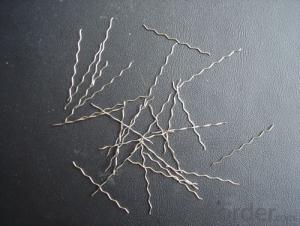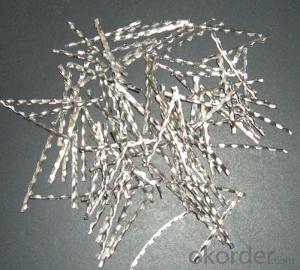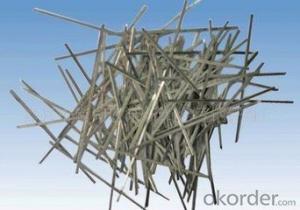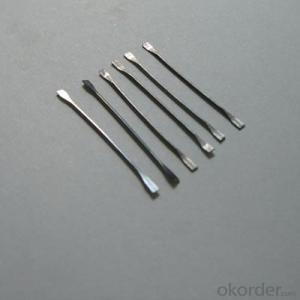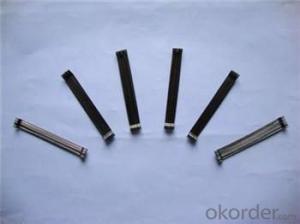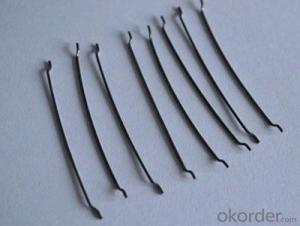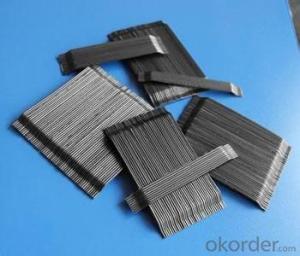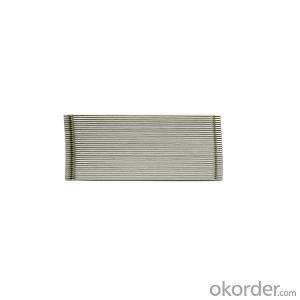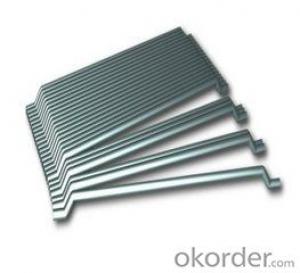Steel Fiber Straight Type CE Approved High Quality Hooked
- Loading Port:
- Tianjin
- Payment Terms:
- TT OR LC
- Min Order Qty:
- 5 kg
- Supply Capability:
- 30000 kg/month
OKorder Service Pledge
OKorder Financial Service
You Might Also Like
Quick Details
Place of Origin: Jiangsu, China (Mainland)
Model Number: HT-ST
Material: Steel
Specifications
Steel fiber types includs,
a) Hooked ends steel fiber
b) Flat head steel fiber
c) Needle-flat steel fiber
d) Wavy steel fiber
e) Xorex steel fiber
f) Micro-steel fiber
g) stainless steel fiber
Application of Daye steel fiber:
A. Tunnel pre-treatment(primary support)
B. Tunnel forming(permanent lining)
C. Slope stabilization
D. Ditch excavation support
E. Industrial floor
F. Precast concrete element
G. Concrete restoration
H. High performance concrete
Picture
Steel fiber straight type
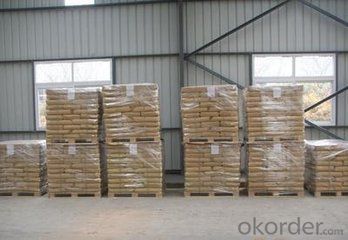
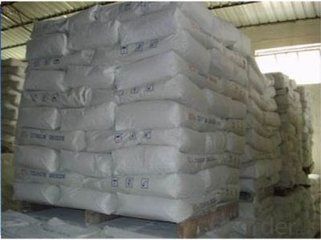
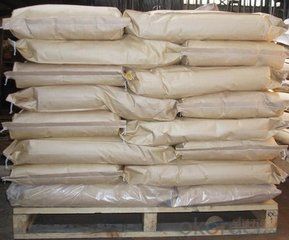
Wavy steel fiber
Xorex steel fiber
Micro-steel fiber
FAQ
certificated: ISO 9001
Technical advantages of Daye steel fiber:
A. Improve mechanical performance of concrete
B. Provide uniform distribution throughout concrete with excellent mixing
C. No balling or caking by adopt correct mixing method
D. Reduce concrete volume
E.Save construction time and cost
F.Reduce excavation volume
G.Available for jointless floor.
- Q:What is the recommended spacing between melt extract stainless steel fibers in concrete?
- The recommended spacing between melt extract stainless steel fibers in concrete typically ranges from 1 inch to 2 inches.
- Q:Can melt extract stainless steel fiber be used in tunnel linings for underground mining?
- Yes, melt extract stainless steel fiber can be used in tunnel linings for underground mining. These fibers are known for their high tensile strength and resistance to corrosion, making them suitable for reinforcing concrete in harsh environments such as mines. Additionally, their superior durability and ability to enhance the structural integrity of tunnel linings make them a reliable choice for underground mining applications.
- Q:How does melt extract stainless steel fiber improve the resistance to spalling in shotcrete?
- Melt extract stainless steel fiber enhances the resistance to spalling in shotcrete by reinforcing the concrete matrix. The fibers are dispersed uniformly throughout the shotcrete, creating a three-dimensional network that improves the overall strength and durability of the material. This reinforcement reduces the formation and propagation of cracks, thereby minimizing the risk of spalling under various loading conditions. Additionally, the stainless steel fibers act as a barrier to inhibit the ingress of moisture and other aggressive substances that can contribute to spalling.
- Q:What is the effect of melt extract stainless steel fiber on the alkali-silica reaction in concrete?
- Melt extract stainless steel fiber has a generally positive effect on the alkali-silica reaction in concrete. The alkali-silica reaction is a chemical reaction that occurs between the alkalis in cement and specific types of reactive silica found in concrete aggregates. This reaction can lead to significant expansion, cracking, and deterioration of the concrete over time. Nevertheless, the inclusion of melt extract stainless steel fibers in the concrete mix can serve as reinforcement and aid in mitigating the effects of the alkali-silica reaction. These stainless steel fibers offer additional structural support to the concrete, reducing the likelihood of cracking and enhancing the overall durability of the material. The stainless steel fibers also assist in controlling the expansion caused by the alkali-silica reaction by acting as a physical barrier that limits the movement of reactive silica particles. This barrier is effective in preventing crack formation and minimizing the damage caused by the reaction. Furthermore, the stainless steel fibers improve the mechanical properties of the concrete, including tensile strength, flexural strength, and impact resistance. This enhancement further enhances the concrete's performance in various applications, particularly in high-stress environments or structures where durability is of utmost importance. In conclusion, incorporating melt extract stainless steel fiber into concrete can effectively reduce the adverse effects of the alkali-silica reaction, resulting in improved long-term performance and durability of the concrete.
- Q:Can melt extract stainless steel fiber be used in tunnel shotcreting applications?
- Yes, melt extract stainless steel fiber can be used in tunnel shotcreting applications. Tunnel shotcreting is a process of applying concrete or mortar mix to the walls of a tunnel or underground structure using a spraying technique. The addition of stainless steel fibers to the shotcrete mix can provide reinforcement and improve the overall performance and durability of the sprayed concrete. Melt extract stainless steel fibers are commonly used in shotcrete applications due to their high tensile strength, corrosion resistance, and ability to enhance the post-cracking behavior of the concrete. These fibers are typically made by melting stainless steel and then rapidly cooling it to form fine, elongated fibers. The use of stainless steel fibers in tunnel shotcreting can help mitigate the formation of cracks and control crack propagation, thereby increasing the structural integrity and longevity of the sprayed concrete. The fibers also improve the resistance of the shotcrete to impact, abrasion, and spalling, which are common challenges in tunnel construction. Furthermore, the addition of stainless steel fibers can enhance the overall performance of the shotcrete by reducing shrinkage and improving the bond strength between the shotcrete and the tunnel surface. This is particularly important in tunnel shotcreting applications where the sprayed concrete needs to adhere well to the surrounding rock or soil. In conclusion, melt extract stainless steel fiber can be effectively used in tunnel shotcreting applications to enhance the durability, strength, and performance of the sprayed concrete. Its incorporation can help overcome common challenges in tunnel construction and improve the overall quality of the tunnel walls.
- Q:Can melt extract stainless steel fiber reduce the risk of spalling in high-strength concrete?
- The inclusion of melt extract stainless steel fibers in high-strength concrete is beneficial for preventing spalling. Spalling is a common issue in high-strength concrete, especially when it is exposed to high temperatures or fire. The utilization of stainless steel fibers enhances the concrete's capacity to withstand thermal stresses and prevents spalling. Stainless steel fibers possess exceptional mechanical properties, such as high tensile strength and corrosion resistance. These fibers reinforce the concrete matrix and enhance its overall durability when incorporated into high-strength concrete. They act as a reinforcement, evenly distributing the load and minimizing the risk of cracking and spalling. The unique characteristics of melt extract stainless steel fibers make them highly effective in preventing spalling. These fibers are typically very fine with diameters ranging from 0.1 to 0.3 mm. This allows for easy dispersion and even distribution throughout the concrete mixture, effectively reinforcing the entire structure. Furthermore, stainless steel fibers have a high melting point and excellent thermal conductivity. When exposed to high temperatures, the fibers dissipate heat and decrease the thermal gradients within the concrete. This prevents the formation of internal stresses that can result in spalling. In conclusion, the addition of melt extract stainless steel fibers to high-strength concrete significantly reduces the risk of spalling. These fibers reinforce the matrix, enhance its resistance to cracking, and improve its ability to withstand thermal stresses. By preventing spalling, the concrete's structural integrity and longevity are improved, resulting in a safer and more durable material.
- Q:How does melt extract stainless steel fiber improve the resistance of concrete to chloride ingress?
- The utilization of melt extract stainless steel fiber is essential in enhancing the concrete's resistance against chloride infiltration. When incorporated into the concrete mixture, these stainless steel fibers create a physical barrier that hampers the movement of chloride ions into the concrete matrix. Chloride ions are a primary factor in the corrosion of reinforced concrete structures. They infiltrate the concrete and reach the steel reinforcement, resulting in corrosion and eventual deterioration. This not only compromises the concrete's structural integrity but also diminishes its lifespan. By introducing melt extract stainless steel fibers into the concrete, the permeability of the material is effectively reduced, thereby limiting the entry of chloride ions. These fibers establish a network within the concrete, forming a three-dimensional reinforcement system that restricts the movement of chloride ions. Additionally, the stainless steel fibers enhance the concrete's mechanical properties, rendering it more resistant to cracking and spalling caused by chloride-induced corrosion. They improve the concrete's tensile and flexural strength, minimizing the potential formation and propagation of cracks. Moreover, melt extract stainless steel fibers serve as sacrificial anodes, preventing the corrosion of the steel reinforcement. As the chloride ions come into contact with the stainless steel fibers, they are attracted to the fibers instead of the reinforcement, thereby reducing the risk of corrosion. In conclusion, melt extract stainless steel fibers enhance the concrete's resistance to chloride infiltration by establishing a physical barrier, reducing permeability, improving mechanical properties, and acting as sacrificial anodes. These fibers significantly prolong the lifespan of concrete structures by mitigating the detrimental effects of chloride-induced corrosion.
- Q:How does the addition of melt extract stainless steel fiber affect the creep behavior of concrete?
- Concrete's creep behavior is positively affected by the inclusion of melt extract stainless steel fiber. Creep refers to the gradual deformation of concrete over time under a constant load and is a significant issue in structural applications since it can result in long-term deformation and structural failure. By incorporating melt extract stainless steel fibers into the concrete mix, the material's overall mechanical properties are improved. The fibers function as reinforcement, imparting additional tensile strength and enhancing the concrete's resistance to cracking and deformation. Moreover, the steel fibers play a role in reducing concrete's overall creep. They act as internal support, opposing the movement and redistribution of stresses within the concrete matrix. This reinforcement effect aids in the more even distribution of the applied load, thereby diminishing the potential for long-term deformation. Additionally, melt extract stainless steel fibers enhance the durability of concrete by boosting its resistance to environmental factors like shrinkage, thermal cycling, and aggressive chemicals. This heightened durability contributes to the long-term stability and performance of concrete structures. In conclusion, incorporating melt extract stainless steel fibers into concrete enhances its creep behavior by improving its mechanical properties and reducing the likelihood of long-term deformation. This reinforcement effect results in increased structural integrity and durability, making it an effective solution for applications where creep resistance is a concern.
- Q:Can melt extract stainless steel fiber be used in lightweight aggregate concrete wall panels?
- Indeed, melt extract stainless steel fiber is a viable option for utilization in lightweight aggregate concrete wall panels. It is a common practice to incorporate stainless steel fibers into concrete as a means of augmenting its tensile strength, crack resistance, and durability. Lightweight aggregate concrete, on the other hand, is produced by substituting traditional coarse aggregate with lightweight materials like expanded clay or shale. This substitution offers several benefits, such as a reduction in dead load, improved thermal insulation, and enhanced fire resistance. When combining melt extract stainless steel fibers with lightweight aggregate concrete, the resultant wall panels acquire the added reinforcement provided by the fibers. This reinforcement serves to avert cracking and enhance the overall structural integrity of the panels. Moreover, stainless steel fibers possess corrosion-resistant properties, which are particularly vital for concrete applications that are exposed to harsh environments or moisture. The integration of melt extract stainless steel fibers into lightweight aggregate concrete wall panels can also heighten their resistance against impact and blast loads, making them suitable for use in regions prone to earthquakes or explosions. Furthermore, the inclusion of stainless steel fibers can amplify the ductility and flexural strength of the panels, enabling them to better withstand external forces and deformations. In conclusion, melt extract stainless steel fibers can be effectively implemented in lightweight aggregate concrete wall panels to improve their mechanical properties, durability, and performance across a variety of applications.
- Q:How does melt extract stainless steel fiber contribute to the ductility of concrete?
- Melt extract stainless steel fibers contribute to the ductility of concrete in several ways. Firstly, these fibers are added to the concrete mixture in small proportions, which enhances the overall flexural and tensile strength of the concrete. This results in a more ductile material that can withstand greater loads and resist cracking. Secondly, the unique properties of stainless steel, such as high tensile strength and corrosion resistance, make it an ideal material for reinforcing concrete. When added as fibers, the stainless steel provides additional reinforcement throughout the concrete matrix, increasing its overall toughness and ductility. Furthermore, the randomly dispersed stainless steel fibers act as micro-crack arrester, preventing the propagation of cracks and enhancing the post-cracking behavior of the concrete. This means that even if cracks do occur, they are less likely to propagate and lead to catastrophic failure. In addition, the melt extract stainless steel fibers improve the bond between the concrete matrix and the fibers themselves. This improved bond allows for more effective load transfer between the fibers and the surrounding concrete, further enhancing the ductility of the material. Overall, melt extract stainless steel fibers contribute to the ductility of concrete by improving its flexural and tensile strength, enhancing crack resistance, and improving the bond between the fibers and the concrete matrix. This results in a more durable and resilient material that can withstand greater loads and deformation without failure.
1. Manufacturer Overview |
|
|---|---|
| Location | |
| Year Established | |
| Annual Output Value | |
| Main Markets | |
| Company Certifications | |
2. Manufacturer Certificates |
|
|---|---|
| a) Certification Name | |
| Range | |
| Reference | |
| Validity Period | |
3. Manufacturer Capability |
|
|---|---|
| a)Trade Capacity | |
| Nearest Port | |
| Export Percentage | |
| No.of Employees in Trade Department | |
| Language Spoken: | |
| b)Factory Information | |
| Factory Size: | |
| No. of Production Lines | |
| Contract Manufacturing | |
| Product Price Range | |
Send your message to us
Steel Fiber Straight Type CE Approved High Quality Hooked
- Loading Port:
- Tianjin
- Payment Terms:
- TT OR LC
- Min Order Qty:
- 5 kg
- Supply Capability:
- 30000 kg/month
OKorder Service Pledge
OKorder Financial Service
Similar products
New products
Hot products
Related keywords
